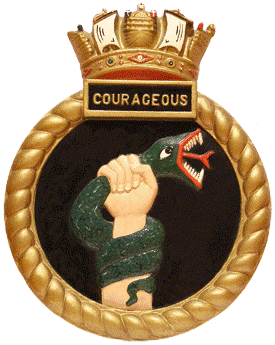
HMS Courageous served the Royal Navy and the United Kingdom for 22 years from her commissioning in 1971 to her paying off, at Plymouth, in 1993.
Her fate was expected to be the same as her predecessors and it was planned for her to be defuelled and eventually scrapped. However, the MoD felt that it was important to demystify the nuclear submarines operated by the Royal Navy and to inform the public of their role. It was therefore decided to select one of the submarines earmarked for disposal and restore it to be placed on display. It was pure chance that HMS Courageous was the most recent boat to have undergone a hull and safety survey and she was therefore chosen to be the exhibited boat. There was considerable work to be
conducted in order to make her fit for display and she was placed into a dry dock in Devonport's South Yard.
Work began and a team of volunteers came forward, many of them former crew members, to support the ongoing restoration. A great deal of work was carried out, and, to be honest, has continued ever since, to ensure that the boat was exhibited and provided a memorable experience for visitors. One of the problems which became apparent was the material condition of the caissoon (watertight, floatable gate which prevents water entering the dry dock). It was in such a poor state of repair that it needed to be replaced or repaired. The former option was prohibitively expensive and, therefore, the life of the caissoon was extended until the necessary work could be carried out.
In order to carry out the work on the caissoon Courageous needed to be moved out of the dock and, in order to manage that, she had to undergo watertight testing. Once this was achieved she was moved into 3 basin where she remains to the current day.
Visitor tours continued and excellent feedback was received from those who visited, however, the difficulty was always her location. As she was, and still is, within the secure area of the Royal Naval Dockyard, security clearance had to be obtained for all visitors and this took approximately a week to obtain. It was clearly unsatisfactory but, with the undoubted success of the boat as a display a solution was identified.
A feasibility study was conducted and with the support of Plymouth City Council and the National Museum for the Royal Navy, (NMRN) it was proven that Courageous could be moved outside of the secure dockyard perimeter, into a purpose built Cold War Museum complex where Courageous would become the centrepiece of a multi exhibit experience. This project seemed to be forging ahead when Covid struck. The boat was prevented from opening to visitors, as were the museums operated by the NMRM. Local authorities were forced to spend vast amounts in Covid prevention measures and the project dropped down the list of priorities. The overall effect was such that, in the long run, the NMRN and other supporters decided that they were no longer able to support the project and it stalled and is currently in the balance.


Courageous currently sits in 3 basin however, in the picture shown here she is looking sorry for herself. This is not her current state and, toward the end of Covid restrictions she was once again taken into dry dock where she underwent considerable maintenance, including repainting, restoration and preservation of damaged areas of the casing (upper deck) and, internally, she was brought up to the required health and safety standards with improved ventilation, low voltage safe lighting and other measures.
For the docking all internal exhibit items were removed by the volunteers who then replaced them after the boat returned to the basin.
There is a limited programme of visits currently in place and, should you
wish to visit the boat please use the following e mail address to request a visit
Please note - The HMS Courageous Association has no involvement with the management of the exhibit and is unable to organise or request visits. If you wish to visit the boat you should use the e mail address shown above.
Sixty members of The Association and their family and guests were recently able to enjoy a visit to the boat. Some former crew members were stepping back onboard for the first time in 50 years while others were able to show their family, for the very first time, where they lived and worked for weeks or months on end. There were many positive comments regarding the work carried out onboard and the excellent condition in which the boat is now presented. She is a credit to the volunteers who have given up many hours to ensure visitors enjoy a first class visit and experience.
The Association would like to express our gratitude to the volunteers who helped arrange and run the visit and who acted as guides (required under current Health and Safety regulation) without whom the visit would not have been possible.



